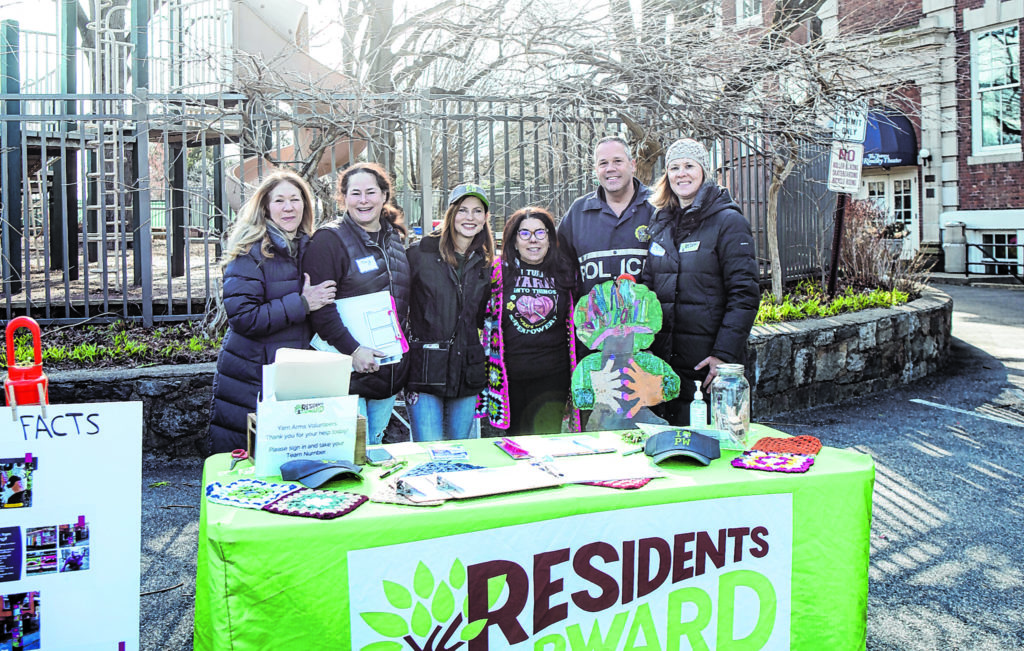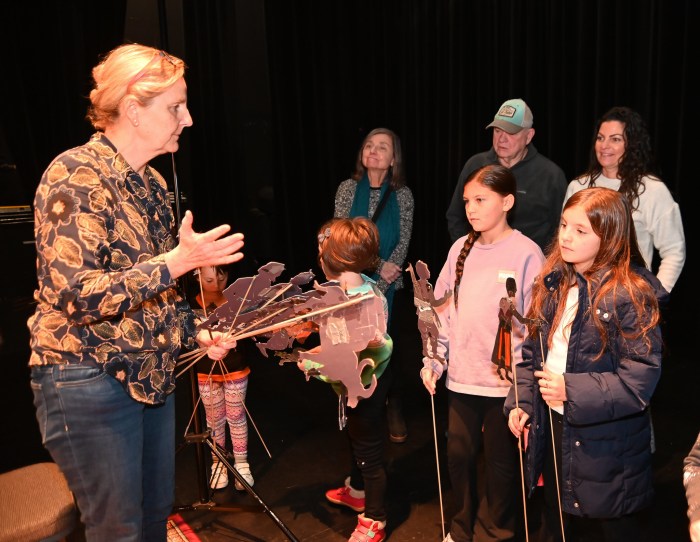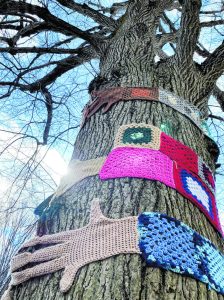
The Port Washington community has come together for a project called “Yarn Arms Around Port” presented by Residents Forward and local activist and fiber artist Allison White. The yarn arms have brought together hundreds of residents to crochet yarn “arms” that wrap around trees along Main Street for the entirety of Earth Month in April. The project not only acts as a fun way to bring the community together and add vibrancy to Main Street, but spreads environmental awareness.
On Saturday, March 26, White, Residents Forward, and about 60 members of the community met up to hang the yarn arms.
“People from all parts of town, all walks of life and kids with their families came to hang the yarn arms,” said White. “We had 10 teams go out up and down Main Street to yarn bomb four to five trees each. We ended up hanging arms on nearly 50 trees.”
“When I first envisioned this project, I was hoping we’d be able to put one arm on every tree,” White added. “But most trees have two arms around them.”
While installing the yarn arms just occurred, the idea and planning for this project began months back.
In January 2020, before the pandemic began, White took a class in New York City with famous fiber artist London Kaye. The course inspired White, so she learned more about Kaye, and the fiber art inspired White’s crocheting during the pandemic.
“When other people were learning to bake bread, I learned to yarn bomb,” said White. Yarn bombing is used to describe hanging colorful crocheted fiber art in public places such as fences, lamp posts and trees.
“At the beginning of COVID-19, people were hanging rainbows for people to spot on their walks,” White said. “I crocheted a rainbow to hang, and I couldn’t believe how many people saw and commented on it on social media or to me in person. I knew if what I was doing as one person was smaller than what we could do as a community.”
White has lived in Port Washington for about 25 years now and knows how many amazing people live in the community, which influenced her idea to create a big community yarn bombing project accessible to all residents.
“I started researching the environmental impact of hanging yarn on trees,” said White. “It made me look closely at the trees. As we go about our business, the environment tends to blend in, and we don’t look at it as closely as we probably should.”
Thus the idea to draw attention to the trees in Port Washington came forward. White decided to look into the town’s rules to learn how to begin the yarn bombing project.
“I called up our town councilwoman, Mariann Dalimonte, and she loved the idea,” said White.
Dalimonte explained how to get town permission and suggested partnering up with a non-profit organization for insurance purposes and to help promote the project.
After that, White contacted Residents Forward, a Port Washington non-profit organization. The director of Residents Forward, Patricia Class, invited White to do a presentation on the project for the Residents Forward board.
“The board was supportive,” said White. “I coordinated the fiber art side, and they coordinated the environmental education program and got the proper paperwork for town approval. We also spoke to two arborists to ensure the arms would be safe for the trees.”
Residents Forward and the Port Washington Public Library co-hosted a Zoom kickoff to the event where over 70 people joined to learn about the project. White and Residents Forward planned “learn to crochet” nights at Crazy Cakes, located at 52 Main St., where adults ranging from those who’ve never crocheted before to reasonably skilled crocheters met up to learn how to make the granny squares that would make up the yarn arms. Additionally, the library hosted a “learn to crochet” night for children to learn to participate in the project.
“So, people were making granny squares for many months,” said White. “I picked the granny squares because they are good for beginners to make. The only requirement was that it had to be an eight-inch square made out of acrylic yarn. We used acrylic yarn because it doesn’t retain water as natural wool yarn.”
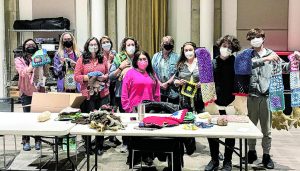
(Photo from the Port Washington Public Library)
“We had a library session for people to learn how to make the hands,” said White. The Knitting Place, located at 191 Main St., donated different color yarn for different skin-toned hands. “It was a great contribution,” said White.
Over 500 granny squares were collected for the arms, varying in color and design. Crocheters came up with creative ideas along the way and shared the techniques with other crocheters.
“People formed friendships through this project,” said White. “Several people that moved to the town during the pandemic got to be part of something in the community and meet people in town for the first time.”
A Weber Middle School teacher, Maria Shapiro, worked on the environmental education committee for the project, and she took her students out to measure the trees for the arms. The students were able to identify the species of the various trees and learn scientific facts about each species.
“These facts were printed on laminated tree-labels that we attached to every tree,” said White. “So when you walk around and see a yarn arm, a tag tells you the particular tree species and what it contributes to the environment.”
Many other non-profit organizations helped out with the “Yarn Arms Around Port” project, such as the Littig House, The Nicholas Center, The Hellen Keller Center, and the Historical Society. Each organization helped promote the project, and some participated in creating the yarn arms.
“The Hellen Keller center suggested using a hand with sign language, so we made one that says ‘I love you’ in sign language,” said White. “And people at the Nicholas Center helped me wrap yarn around clothes pins to tie up the arms on the tree.”
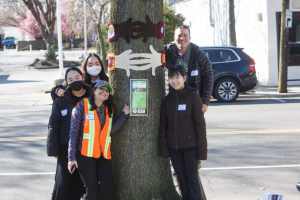
“One of my goals was not only to bring people together and raise environmental awareness, but it was also to attract people to Main Street,” said White. “Helping support our local businesses is important in keeping this town vibrant. One of the environmental education initiatives is an ‘I Love Trees’ video contest, and the winners will each receive a $100 gift certificate to the local business of their choice.”
The beautiful and educational project “required dedication from the community and was a massive labor of love,” said White.



